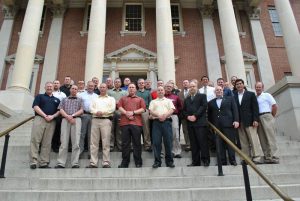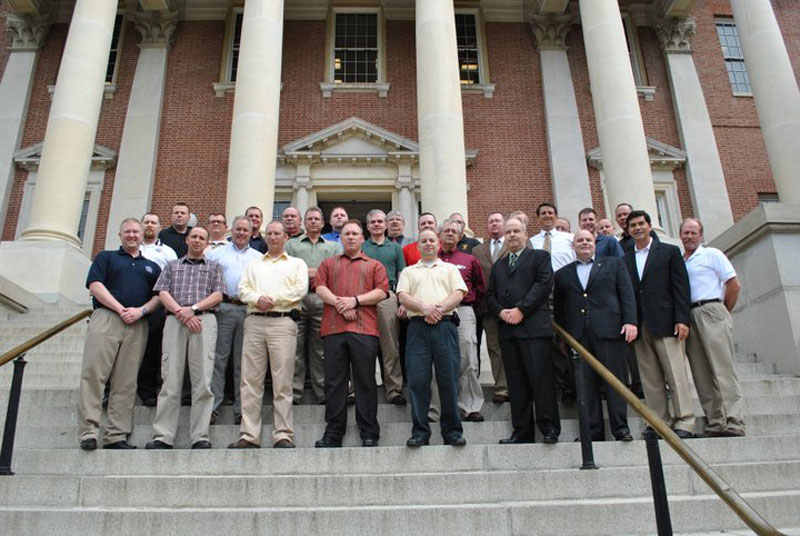 Practical solutions from actual practitioners.
Practical solutions from actual practitioners.
That’s what 26 chiefs, sheriffs, and law enforcement officials from across the country got at the Spring 2011 Rural Law Enforcement Technology Institute.
The event—held for five days in early May in Annapolis, MD—served as a national forum for law enforcement representing small and rural departments to come together and share technology tips that have brought about work-tested solutions.
One such participant was Howard Cook, chief of the Columbia College Police Department in South Carolina.
Under Cook’s watch, the department launched the use of electric “green machines,” including the popular two-wheeled Segway Personal Transporters, electric motorcycles, and four-wheeled, golf cart-like vehicles that allow the department to effectively patrol the 1,500-student campus with less impact on the environment and its budget.
“We have several patrol cars and they put off different emissions,” Cook said. “It’s also costing a lot for gas right now, and also upkeep, maintenance, tires, and brakes for these vehicles.
“But with these green machines, I think it’s important for people to see that there are ways to save money, even in these difficult times,” he continued. “You have to put up an investment up front to get Segways or a motorcycle that’s 100-percent electric, but you can do some of the same police functions and even enhanced functions with these vehicles, with some costing only nine dollars a week to run.”
Hosted each spring and fall by the National Law Enforcement and Corrections Technology Center’s (NLECTC) Small, Rural, Tribal, and Border Regional Center (SRTB-RC)—one of the Public Safety programs operated by The Center for Rural Development—the Institute brings officials together and gives each a platform to share a presentation on low-cost, highly effective technology and planning solutions for common small-agency issues.
They also have ample opportunity to discuss and network with one another on those issues throughout the week.
At the Spring Institute, those issues included radio communications, “off the shelf” technologies, records management, finding creative funding solutions for necessary equipment, and doing more with less funding, among others.
The entire event is presented at no cost to the participating officials.
In Cook’s case, he would not have been able to attend the event had that not been the case.
“My budget would have been prohibitive of that since we’re down at the end of the year,” he said. “This event has allowed me to network with the chiefs and others from departments around the same size as mine who have the same problems or know about great technologies that I need to learn about. If we all share our ideas and technologies we’ve come up with, we can solve most of our problems.”
Such networking is critical to the mission of the Institutes, said Dave Mather, SRTB-RC executive director.
The challenge, he said, is to continue making the 87 percent of the nation’s law enforcement agencies with less than 50 sworn officers—nearly 17,000 total—aware of these networking connections and services available to them through SRTB-RC and other NLECTC Center programs in the country.
“Our outreach specialists and project managers do a great job of attending major conferences and events all over the nation to get the word out about what we can do for them,” Mather said. “But some of our most potent advertising is the testimonials of chiefs and officials here at these Institutes, who almost always come away from our events with information on getting the equipment they need, saving funding, or finding funding to accomplish key services.”
Lonnie Lawson, president and CEO of The Center for Rural Development, agreed. The Center is the Somerset, Ky.-based organization that operates SRTB-RC and other national Public Safety programs.
“The Institutes bring together real-world practitioners to share ideas and look for commonalities in the way they do business on a day-to-day basis,” Lawson said, “and we encourage the agencies we serve to look for affordable solutions to the problems they encounter.”
The Spring Institute represents the eleventh such event organized and hosted by SRTB-RC, one of four resource and outreach centers in the NLECTC system within the National Institute of Justice, a program of the U.S. Department of Justice.
Presentations delivered at the events can be on how an agency addressed an issue, can present a problem to the group for input on a solution, or can impart lessons learned during the implementation of a particular technology. SRTB-RC also arranges for presentations from other NIJ Centers and staff on services available to them from the federal government or other resources.
In addition to the presentations, the Institute also featured a technology demonstration held at the Bay Bridge Airport during which the participants were divided into several groups, and were given the opportunity to move through different stations where demonstrating products were being exhibited.
These technologies included: a low-cost firearms simulator; Segways; eGuardian Web-based information-sharing system hosted by the FBI; and electronic license-plate readers—all top technologies being tested by SRTB-RC and NIJ.
Participants also were able to fly along in a light-sport “gyroplane” aircraft similar to those used as part of NIJ’s Law Enforcement Aviation Technology Program. The aircraft was flown by Michael O’Shea, an avid pilot and the law enforcement program manager for the U.S. Department of Justice’s NLECTC system.
These aircraft, Mather said, can perform essential law enforcement-related surveillance and other flight-related activities but at a tenth of the cost per flight hour when compared to a traditional helicopter.
“The aviation program is a great example of how technology demonstrations benefit the law enforcement community. If you talk about using a gyroplane as an aviation asset, you won’t find many takers,” Mather said. “But get them up in the air and demonstrate the abilities by simulating real-world missions, and it makes an impact you can’t get from a PowerPoint presentation.”
In addition to being exposed to this technology, attendees also get the benefit of becoming a part of a network of new resources built during the Institutes.
“Everyone receives the full contact list for all current participants, as well as contact information for all past attendees and topics they presented,” Mather said. “Again this time, we heard more than one participant say this was among the best training they had ever had.”
Mike Luvera, captain of the Central Washington University Police Department, agreed.
“With all of us being from smaller agencies, we’re all in the same boat,” Luvera said. “I’ve now made some contacts that I know I will keep and use for the rest of my career, and that won’t just better me, it’s going to better my agency and better the population I serve.
“Without being invited to do this and being sponsored like it is, our agency couldn’t have afforded to send me to this, and I wouldn’t have made these contacts and got this great information.”
Patrick Gallagher, chief of the Truth or Consequences, NM Police Department, echoed those sentiments.
“They told us on day one that the most important thing would be the connections and networking we’d be doing, and that hit the nail right on the head,” Gallagher said. “Because of the camaraderie that developed through of the shared problems and issues, I think I’m going to have a relationship with some of these guys for years to come as a result of this Institute.”





